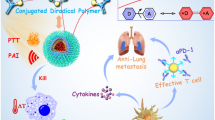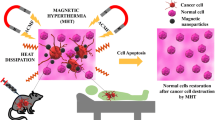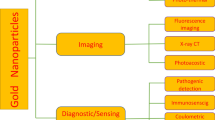Abstract
Photothermal agents, which can convert near-infrared light into heat with a minimal attenuation of the energy and prevent undesirable thermal damage to healthy tissue, provided an opportunity for accurate heat delivery to desired sites. Herein, we designed cyclo(Arg-Gly-Asp-D-Tyr-Lys) peptide c(RGDyK)-conjugated TiO2 nanoparticles (TiO2-RGD NPs) with an ideal biocompatibility and targeting property. TiO2-RGD NPs exhibited intense absorbance in near-infrared region, a high stability in physiological conditions, and the photothermal conversion efficiency of ~38.5%. Due to the specific affinity between c(RGDyK) and αvβ3 integrin, TiO2-RGD NPs showed the high targeting property for U87-MG cells with overexpression of αvβ3 integrin. After incubation with TiO2-RGD NPs (100 µg/mL) and under 808 nm near-infrared laser irradiation (1 W/cm2), the viability of MCF-7 cells by deficient expression of αvβ3 integrin was ~71%, while the viability of U87-MG decreased to ~31%, which have been demonstrated as an effective targeting photothermal therapy agent.






Similar content being viewed by others
References
Lin M, Wang D, Liu S, Huang T, Sun B, Cui Y, Zhang D, Sun H, Zhang H, Sun H, Yang B (2015) Cupreous complex-loaded chitosan nanoparticles for photothermal therapy and chemotherapy of oral epithelial carcinoma. ACS Appl Mater Interfaces 7(37):20801–20812. doi:10.1021/acsami.5b05866
Wang S, Tian Y, Tian W, Sun J, Zhao S, Liu Y, Wang C, Tang Y, Ma X, Teng Z, Lu G (2016) Selectively sensitizing malignant cells to photothermal therapy using a CD44-targeting heat shock protein 72 depletion nanosystem. ACS Nano 10(9):8578–8590. doi:10.1021/acsnano.6b03874
Kang S, Bhang SH, Hwang S, Yoon JK, Song J, Jang HK, Kim S, Kim BS (2015) Mesenchymal stem cells aggregate and deliver gold nanoparticles to tumors for photothermal therapy. ACS Nano 9(10):9678–9690. doi:10.1021/acsnano.5b02207
Ke H, Wang J, Dai Z, Jin Y, Qu E, Xing Z, Guo C, Yue X, Liu J (2011) Gold-nanoshelled microcapsules: a theranostic agent for ultrasound contrast imaging and photothermal therapy. Angew Chem 50(13):3017–3021. doi:10.1002/anie.201008286
Liu H, Chen D, Li L, Liu T, Tan L, Wu X, Tang F (2011) Multifunctional gold nanoshells on silica nanorattles: a platform for the combination of photothermal therapy and chemotherapy with low systemic toxicity. Angew Chem 50(4):891–895. doi:10.1002/anie.201002820
Rengan AK, Bukhari AB, Pradhan A, Malhotra R, Banerjee R, Srivastava R, De A (2015) In vivo analysis of biodegradable liposome gold nanoparticles as efficient agents for photothermal therapy of cancer. Nano Lett 15(2):842–848. doi:10.1021/nl5045378
Tsai MF, Chang SH, Cheng FY, Shanmugam V, Cheng YS, Su CH, Yeh CS (2013) Au nanorod design as light-absorber in the first and second biological near-infrared windows for in vivo photothermal therapy. ACS Nano 7(6):5330–5342. doi:10.1021/nn401187c
Zhang L, Chen Y, Li Z, Li L, Saint-Cricq P, Li C, Lin J, Wang C, Su Z, Zink JI (2016) Tailored synthesis of octopus-type janus nanoparticles for synergistic actively-targeted and chemo-photothermal therapy. Angew Chem 55(6):2118–2121. doi:10.1002/anie.201510409
Zheng T, Li GG, Zhou F, Wu R, Zhu JJ, Wang H (2016) Gold-nanosponge-based multistimuli-responsive drug vehicles for targeted chemo-photothermal therapy. Adv Mater 28(37):8218–8226. doi:10.1002/adma.201602486
Yao X, Niu X, Ma K, Huang P, Grothe J, Kaskel S, Zhu Y (2016) Graphene quantum dots-capped magnetic mesoporous silica nanoparticles as a multifunctional platform for controlled drug delivery, magnetic hyperthermia, and photothermal therapy. Small. doi:10.1002/smll.201602225
Akhavan O, Ghaderi E (2013) Graphene nanomesh promises extremely efficient in vivo photothermal therapy. Small 9(21):3593–3601. doi:10.1002/smll.201203106
Hs DJ, Kong WH, Sung DK, Lee MY, Beack SE, Keum DH, Kim KS, Yun SH, Hahn SK (2014) Nanographene oxide-hyaluronic acid conjugate for photothermal ablation therapy of skin cancer. ACS Nano 8(1):260–268. doi:10.1021/nn405383a
Mou J, Li P, Liu C, Xu H, Song L, Wang J, Zhang K, Chen Y, Shi J, Chen H (2015) Ultrasmall Cu2-x S nanodots for highly efficient photoacoustic imaging-guided photothermal therapy. Small 11(19):2275–2283. doi:10.1002/smll.201403249
Liu J, Wang P, Zhang X, Wang L, Wang D, Gu Z, Tang J, Guo M, Cao M, Zhou H, Liu Y, Chen C (2016) Rapid degradation and high renal clearance of Cu3BiS3 nanodots for efficient cancer diagnosis and photothermal therapy in Vivo. ACS Nano 10(4):4587–4598. doi:10.1021/acsnano.6b00745
Zhang S, Sun C, Zeng J, Sun Q, Wang G, Wang Y, Wu Y, Dou S, Gao M, Li Z (2016) Ambient aqueous synthesis of ultrasmall PEGylated Cu2-x Se nanoparticles as a multifunctional theranostic agent for multimodal imaging guided photothermal therapy of cancer. Adv Mater 28(40):8927–8936. doi:10.1002/adma.201602193
Wang J, Zhao H, Zhou Z, Zhou P, Yan Y, Wang M, Yang H, Zhang Y, Yang S (2016) MR/SPECT imaging guided photothermal therapy of tumor-targeting Fe@Fe3O4 nanoparticles in vivo with low mononuclear phagocyte uptake. ACS Appl Mater Interfaces 8(31):19872–19882. doi:10.1021/acsami.6b04639
Wang J, Zhou Z, Wang L, Wei J, Yang H, Yang S, Zhao J (2015) CoFe2O4@MnFe2O4/polypyrrole nanocomposites for in vitro photothermal/magnetothermal combined therapy. RSC Adv 5(10):7349–7355. doi:10.1039/c4ra12733a
Guo Z, Zou Y, He H, Rao J, Ji S, Cui X, Ke H, Deng Y, Yang H, Chen C, Zhao Y, Chen H (2016) Bifunctional platinated nanoparticles for photoinduced tumor ablation. Adv Mater. doi:10.1002/adma.201602738
Church GM (2015) Precision chemistry for precision medicine. ACS Cent Sci 1(1):11–13. doi:10.1021/acscentsci.5b00088
Haubner R, Gratias R, Diefenbach B, Goodman SL, Jonczyk A, Kessler H (1996) Structural and functional aspects of RGD-containing cyclic pentapeptides as highly potent and selective integrin αVβ3 antagonists. J Am Chem Soc 118(32):7461–7472. doi:10.1021/ja9603721
Desgrosellier JS, Cheresh DA (2010) Integrins in cancer: biological implications and therapeutic opportunities. Nat Rev Cancer 10(1):9
Cai W, Shin D-W, Chen K, Gheysens O, Cao Q, Wang SX, Gambhir SS, Chen X (2006) Peptide-labeled near-infrared quantum dots for imaging tumor vasculature in living subjects. Nano Lett 6(4):669–676. doi:10.1021/nl052405t
Danhier F, Breton AL, Préat V (2012) RGD-based strategies to target alpha(v) beta(3) Integrin in cancer therapy and diagnosis. Mol Pharm 9(11):2961
Xie J, Chen K, Lee H-Y, Xu C, Hsu AR, Peng S, Chen X, Sun S (2008) Ultrasmall c(RGDyK)-coated Fe3O4 nanoparticles and their specific targeting to integrin αvβ3-rich tumor cells. J Am Chem Soc 130(24):7542–7543. doi:10.1021/ja802003h
Yang H, Qin C, Yu C, Lu Y, Zhang H, Xue F, Wu D, Zhou Z, Yang S (2014) RGD-conjugated nanoscale coordination polymers for targeted T1- and T2-weighted magnetic resonance imaging of tumors in Vivo. Adv Func Mater 24(12):1738–1747. doi:10.1002/adfm.201302433
An L, Hu H, Du J, Wei J, Wang L, Yang H, Wu D, Shi H, Li F, Yang S (2014) Paramagnetic hollow silica nanospheres for in vivo targeted ultrasound and magnetic resonance imaging. Biomaterials 35(20):5381–5392. doi:10.1016/j.biomaterials.2014.03.030
Yang H, Zhuang Y, Sun Y, Dai A, Shi X, Wu D, Li F, Hu H, Yang S (2011) Targeted dual-contrast T1- and T2-weighted magnetic resonance imaging of tumors using multifunctional gadolinium-labeled superparamagnetic iron oxide nanoparticles. Biomaterials 32(20):4584–4593. doi:10.1016/j.biomaterials.2011.03.018
Choi J, Song S, Horantner MT, Snaith HJ, Park T (2016) Well-defined nanostructured, single-crystalline TiO2 electron transport layer for efficient planar perovskite solar cells. ACS Nano 10(6):6029–6036. doi:10.1021/acsnano.6b01575
Zhang J, Jin X, Morales-Guzman PI, Yu X, Liu H, Zhang H, Razzari L, Claverie JP (2016) Engineering the absorption and field enhancement properties of Au-TiO2 nanohybrids via whispering gallery mode resonances for photocatalytic water splitting. ACS Nano 10(4):4496–4503. doi:10.1021/acsnano.6b00263
Lu X, Chen A, Luo Y, Lu P, Dai Y, Enriquez E, Dowden P, Xu H, Kotula PG, Azad AK, Yarotski DA, Prasankumar RP, Taylor AJ, Thompson JD, Jia Q (2016) Conducting interface in oxide homojunction: understanding of superior properties in black TiO2. Nano Lett 16(9):5751–5755. doi:10.1021/acs.nanolett.6b02454
Deepagan VG, You DG, Um W, Ko H, Kwon S, Choi KY, Yi GR, Lee JY, Lee DS, Kim K, Kwon IC, Park JH (2016) Long-circulating Au-TiO2 nanocomposite as a sonosensitizer for ROS-mediated eradication of cancer. Nano Lett. doi:10.1021/acs.nanolett.6b02547
Harada A, Ono M, Yuba E, Kono K (2013) Titanium dioxide nanoparticle-entrapped polyion complex micelles generate singlet oxygen in the cells by ultrasound irradiation for sonodynamic therapy. Biomater Sci 1(1):65–73. doi:10.1039/c2bm00066k
Ninomiya K, Ogino C, Oshima S, Sonoke S, Kuroda S, Shimizu N (2012) Targeted sonodynamic therapy using protein-modified TiO2 nanoparticles. Ultrason Sonochem 19(3):607–614. doi:10.1016/j.ultsonch.2011.09.009
Yamaguchi S, Kobayashi H, Narita T, Kanehira K, Sonezaki S, Kudo N, Kubota Y, Terasaka S, Houkin K (2011) Sonodynamic therapy using water-dispersed TiO2-polyethylene glycol compound on glioma cells: comparison of cytotoxic mechanism with photodynamic therapy. Ultrason Sonochem 18(5):1197–1204. doi:10.1016/j.ultsonch.2010.12.017
You DG, Deepagan VG, Um W, Jeon S, Son S, Chang H, Yoon HI, Cho YW, Swierczewska M, Lee S, Pomper MG, Kwon IC, Kim K, Park JH (2016) ROS-generating TiO2 nanoparticles for non-invasive sonodynamic therapy of cancer. Scientific reports 6:23200. doi:10.1038/srep23200
Miyoshi N, Kume K, Tsutumi K, Fukunaga Y, Ito S, Imamura Y, Bibin AB (2011) Application of titanium dioxide (TiO2) nanoparticles in photodynamic therapy (PDT) of an experimental tumor. AIP Conf Proc 1415(1):21–23. doi:10.1063/1.3667210
Goncalves RH, Schreiner WH, Leite ER (2010) Synthesis of TiO2 nanocrystals with a high affinity for amine organic compounds. Langmuir ACS J Surf Coll 26(14):11657–11662. doi:10.1021/la1007473
Gordon TR, Cargnello M, Paik T, Mangolini F, Weber RT, Fornasiero P, Murray CB (2012) Nonaqueous synthesis of TiO2 nanocrystals using TiF4 to engineer morphology, oxygen vacancy concentration, and photocatalytic activity. J Am Chem Soc 134(15):6751–6761. doi:10.1021/ja300823a
Dong A, Ye X, Chen J, Kang Y, Gordon T, Kikkawa JM, Murray CB (2011) A generalized ligand-exchange strategy enabling sequential surface functionalization of colloidal nanocrystals. J Am Chem Soc 133(4):998–1006. doi:10.1021/ja108948z
Guo Y, Yuan H, Rice WL, Kumar AT, Goergen CJ, Jokivarsi K, Josephson L (2012) The PEG-fluorochrome shielding approach for targeted probe design. J Am Chem Soc 134(47):19338–19341. doi:10.1021/ja309085b
Liu Y, Ai K, Liu J, Deng M, He Y, Lu L (2013) Dopamine-melanin colloidal nanospheres: an efficient near-infrared photothermal therapeutic agent for in vivo cancer therapy. Adv Mater 25(9):1353–1359. doi:10.1002/adma.201204683
Acknowledgements
This work was partially supported by National Natural Science Foundation of China (Nos. 21371122, and 21571130, 21671135), the Ministry of Education of China (PCSIRT_IRT_16R49), and International Joint Laboratory on Resource Chemistry of Ministry of Education (IJLRC).
Author information
Authors and Affiliations
Corresponding authors
Electronic supplementary material
Below is the link to the electronic supplementary material.
Rights and permissions
About this article
Cite this article
Zhao, H., Wang, M., Zhou, P. et al. RGD-conjugated titanium dioxide nanoparticles: targeted near-infrared photothermal therapy for αvβ3 integrin overexpressed cancer cells. J Mater Sci 52, 13356–13364 (2017). https://doi.org/10.1007/s10853-017-1083-9
Received:
Accepted:
Published:
Issue Date:
DOI: https://doi.org/10.1007/s10853-017-1083-9




